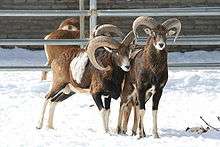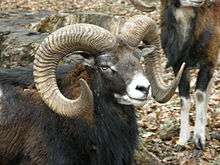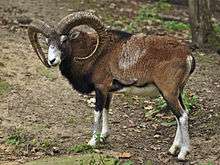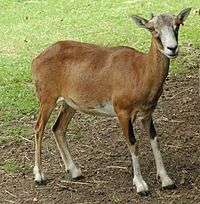Mouflon
The mouflon (Ovis orientalis orientalis[2] group) is a subspecies group of the wild sheep (Ovis orientalis). Populations of O. orientalis can be partitioned into the mouflons (orientalis group) and the urials (vignei group).[2] The mouflon is thought to be the ancestor for all modern domestic sheep breeds.[3][4]
| Mouflon | |
|---|---|
 | |
| A group of mouflon at the Buffalo Zoo | |
| Scientific classification | |
| Kingdom: | Animalia |
| Phylum: | Chordata |
| Class: | Mammalia |
| Order: | Artiodactyla |
| Family: | Bovidae |
| Subfamily: | Caprinae |
| Genus: | Ovis |
| Species: | O. orientalis |
| Binomial name | |
| Ovis orientalis | |
| Synonyms | |
|
Ovis aries | |
Etymology
The wild sheep of Corsica were locally called mufro (male) and mufra (female). The French naturalist Buffon (1707–1788) rendered this in French as moufflon.[5]
Description

Mouflon sheep have reddish to dark brown, short-haired coats with dark back stripes and black ventral areas and light-colored saddle patches. The males are horned; some females are horned, while others are polled. The horns of mature rams are curved in almost one full revolution (up to 85 cm). Mouflon have shoulder heights around 0.9 m and body weights of 50 kg (males) and 35 kg (females).[6]
Range

Today, mouflon inhabit the Caucasus, Anatolia, northern and eastern Iraq, and most parts of Iran and Armenia. The range originally stretched further to the Crimean peninsula and the Balkans, where they had already disappeared 3,000 years ago and came back to Bulgaria. Mouflon were introduced to the islands of Corsica, Sardinia, Rhodes, and Cyprus during the neolithic period, perhaps as feral domesticated animals, where they have naturalized in the mountainous interiors of these islands over the past few thousand years, giving rise to the subspecies known as European mouflon (O. orientalis musimon).
On the island of Cyprus, the mouflon or agrino became a different and endemic subspecies known as the Cyprus mouflon (Ovis gmelini ophion).[7] The Cyprus mouflon population contains only about 3,000 animals. They are now rare on the islands, but are classified as feral animals by the IUCN.[1] European mouflon were later successfully introduced into continental Europe, including Portugal, Spain, France, Germany, central Italy, Switzerland, Austria, the Netherlands, Belgium, the Czech Republic, Poland, Slovakia, Slovenia, Hungary, Bulgaria, Romania, the Canary Islands, and even some northern European countries such as Denmark, Sweden and Finland.
A small colony exists in the remote Kerguelen Islands in the southern Indian Ocean, and on the Veliki Brijun Island in the Brijuni Archipelago of the Istrian Peninsula in Croatia. In South America, mouflon have been introduced into central Chile and Argentina.[8] Since the 1980s, they have also been successfully introduced to game ranches in North America for the purpose of hunting; however, on game ranches, purebreds are rare, as mouflon interbreed with domestic sheep and bighorn sheep. Mouflon have been introduced as game animals into Spieden Island in Washington state, and into the Hawaiian islands of Lanai and Hawaii where they have become a problematic invasive species. A small population escaped from an animal enclosure owned by Thomas Watson, Jr. on the island of North Haven, Maine, in the 1990s and still survives there.
Their normal habitats are steep mountainous woods near tree lines. In winter, they migrate to lower altitudes.[6]
Subspecies

The scientific classification of the mouflon is disputed.[9] Five subspecies of mouflon are distinguished by MSW3:[2]
- Armenian mouflon (Armenian red sheep), Ovis orientalis gmelini (Blyth, 1851), northwestern Iran, Armenia, and Azerbaijan. It has been introduced in Texas, US.
- European mouflon, O. o. musimon (Pallas, 1811) was introduced about 7,000 years ago in Corsica and Sardinia for the first time. It has since been introduced in many parts of Europe.
- Cyprus mouflon, Ovis gmelini ophion (Blyth, 1841), also called agrino (from the Greek Αγρινό), was nearly extirpated during the 20th century. In 1997, about 1,200 of this subspecies were counted. The television show Born to Explore with Richard Wiese reported 3,000 are now on Cyprus.
- Esfahan mouflon, O. o. isphahanica (Nasonov, 1910), is from the Zagros Mountains, Iran.
- Laristan mouflon, O. o. laristanica (Nasonov, 1909), is a small subspecies; its range is restricted to some desert reserves near Lar in southern Iran.
The eastern and the European mouflon often appear in scientific literature as separate species, Ovis musimon and Ovis orientalis. The mouflons are also sometimes treated as a subspecies of the domestic sheep, Ovis aries, named with the same subspecific epithet as above: O. a. musimon, O. a. ophion, etc.[10]
Relation to other sheep
Based on comparison of mitochondrial cytochrome b gene sequences, three groups of sheep (Ovis) have been identified: Pachyceriforms of Siberia (snow sheep) and North America (bighorn and Dall sheep), Argaliforms (argali) of Central Asia, and Moufloniforms (urial, mouflon, and domestic sheep) of Eurasia.[11] However, a comparison of the mitochondrial DNA control region (CR) found that two subspecies of urial, Ovis vignei (or orientalis) arkal and O. v./o. bochariensis, grouped with two different clades of argali (Ovis ammon).[4]
The ancestral sheep is presumed to have had 60 chromosomes, as in goats (Capra). Mouflon and domestic sheep have 54 chromosomes, with three pairs (1+3, 2+8, 5+11) of ancestral acrocentric chromosomes joined to form bi-armed chromosomes. This is in contrast to the argali and urial, which have 56 and 58 chromosomes respectively. If the urial is as closely related to the mouflons as mitochondrial DNA indicates, then two chromosomes would need to have split during its evolution away from the mouflon (sub)species.[11]
Taxonomy
In the Systema Naturæ, Linnaeus and Gmelin treated the mouflon and argali as one species.[12] Von Schreiber used the combination Ovis aries musimon as early as 1782.[13] In 1792, Robert Kerr listed the "Corsican argali" as a separate variety of argali (Ovis Ammon europaea), writing
I have introduced this variety on the authority of Mr Pennant, who distinguishes between the Argali of Corsica and the Siberian, though the difference seems chiefly in colour; one specimen brought from that island by the famous Paoli, differed from the above in colour, having a large white spot on the front of the neck, and being black on the shoulders. In Corsica this animal is named Mufro.[14]
Pallas, grouping goats and sheep together into a single genus Aegoceros, distinguished the mouflon from the argali at species level in 1811 (Ae. musimon and Ae. argali respectively).[15] In 1840 Blyth proposed that the Armenian and Cypriot sheep were also separate species, which he named Ovis Gmelinii (after "the younger Gmelin") and O. Ophion (from a name recorded by Pliny).
Current taxonomy in some sources such as MSW and ITIS treats the mouflons and urials as subspecies of the domestic sheep, Ovis aries Linn. 1758. However ICZN Opinion 2027 conserves the name of the wild species Ovis orientalis S. G. Gmelin 1774 in the case where the wild and domestic varieties are considered conspecific.
Reproduction
Mouflon rams have a strict dominance hierarchy. Before mating season or "rut", which is from late autumn to early winter, rams try to create a dominance hierarchy to determine access to ewes (female mouflon) for mating. Mouflon rams fight one another to obtain dominance and win an opportunity to mate with females. Mouflons reach sexual maturity at the age of 2 to 4 years. Young rams need to obtain dominance before they get a chance to mate, which takes another 3 years for them to start mating. Mouflon ewes also go through a similar hierarchy process in terms of social status in the first 2 years, but can breed even at low status. Pregnancy in females lasts 5 months, in which they produce 1 to 2 offspring.
A mouflon was cloned successfully in early 2001 and lived at least seven months, making it the first clone of an endangered mammal to survive beyond infancy.[16][17][18] This demonstrated that a common species (in this case, a domestic sheep) can successfully become a surrogate for the birth of an exotic animal such as the mouflon. If cloning of the mouflon can proceed successfully, it has the potential to reduce strain on the number of living specimens.
Mouflon in culture
- The mouflon were mentioned to be on Lincoln Island in Jules Verne's The Mysterious Island.
- The mouflon is featured on the symbol of Cyprus Airways, as well as on the 1-, 2-, and 5-cent Cypriot euro coins.
- The mouflon is featured both on the symbol and as the nickname of the Cyprus national rugby union team.
- The mouflon is featured on the historical flag of the Armenian kingdom of Syunik, as well as on the tombstones.
- The similarity of the mouflon to domestic sheep, combined with its threatened status, has made it a subject of interest, both scientific and popular, in the use of biotechnology in species preservation.[19]
See also
References
- Valdez, R. (2008). "Ovis orientalis". IUCN Red List of Threatened Species. 2008. Retrieved 9 May 2017.CS1 maint: ref=harv (link) More specifically, in the island of Cyprus they became a new endemic species only found there, the "Cyprus mouflon" (Ovis orientalis ophion).
- Wilson, Don E.; Reeder, DeeAnn M. (2005). Mammal Species of the World A Taxonomic and Geographic Reference (3rd ed.). Baltimore: Johns Hopkins University Press. ISBN 978-0-8018-8221-0.
- Hiendleder, S; Kaupe, B; Wassmuth, R; Janke, A (2002). "Molecular analysis of wild and domestic sheep questions current nomenclature and provides evidence for domestication from two different subspecies". Proceedings: Biological Sciences. 269 (1494): 893–904. doi:10.1098/rspb.2002.1975. PMC 1690972. PMID 12028771.
- Hiendleder, S.; Mainz, K.; Plante, Y.; Lewalski, H. (1998). "Analysis of mitochondrial DNA indicates that domestic sheep are derived from two different ancestral maternal sources: No evidence for contributions from urial and argali sheep". Journal of Heredity. 89 (2): 113–20. doi:10.1093/jhered/89.2.113. PMID 9542158.
- Page 73 in Blyth, Edward; Owen, R. (1840). "On the species of the genus Ovis". Proceedings of the Zoological Society of London. 8: 62–79.. "The male of this animal is denominated in Corsica Mufro, and the female Mufra, from which Buffon, as it is well known, formed the word Moufflon : and in Sardinia the male is called Murvoni, and the female Murva, though it is not unusual to hear the peasants style both indiscriminately Mufion, which (as Mr. Smyth remarks in his description of that island,) is a palpable corruption of the Greek Ophion."
- MacDonald, David; Priscilla Barret (1993). Mammals of Britain & Europe. 1. London: HarperCollins. pp. 220–221. ISBN 978-0-00-219779-3.
- "Origin, taxonomy and recent development of Cypriot mouflon (Ovis gmelini ophion)". doi:10.1007/BF02240505. Cite journal requires
|journal=(help) - "Mouflon hunting in Chile and Argentina". Archived from the original on 2011-04-16. Retrieved 2011-05-15.
- Tonda, J. (2002). "Ovis ammon". Animal Diversity Web. Retrieved November 19, 2005.
- Encyclopedia of Life, "Ovis aries musimon, European Mouflon Sheep – Names"
- Bunch, Wu, Zhang, Wang (2005). "Phylogenetic analysis of the snow sheep (Ovis nivicola) and closely related taxa", Journal of Heredity, 97 (1) 21–30.
- Musimon is listed as a synonym under Capra Ammon in the 10th (1758) and 12th (1766) editions of Systema Naturæ (ed. 10 p.70; ed. 12 p. 97) and under Ovis Ammon in Gmelin's revised 13th (1788) edition (p. 213). Gmelin notes that the terms "musmon" and "ophion" are found in Pliny.
- ITIS
- Kerr, Robert (1792). The animal kingdom, or zoological system, of the celebrated Sir Charles Linnæus. p. 331
- Pallas (1811). Zoographica Rosso-Asiatica (in Latin), t. 1, p. 230.
- Loi, P; Ptak, G; Barboni, B; Fulka Jr, J; Cappai, P; Clinton, M (2001). "Genetic rescue of an endangered mammal by cross-species nuclear transfer using post-mortem somatic cells". Nature Biotechnology. 19 (10): 962–4. doi:10.1038/nbt1001-962. PMID 11581663.
- Trivedi, Bijal P. (2001). "Scientists Clone First Endangered Species: a Wild Sheep". National Geographic Today. Retrieved February 21, 2006.
- Winstead E (October 12, 2001). "Endangered wild sheep clone reported to be healthy". Genome News Network. Retrieved April 10, 2007.
- E.g. Ptak, G; Clinton, M; Barboni, B; Muzzeddu, M; Cappai, P; Tischner, M; Loi, P (2002). "Preservation of the wild European mouflon: The first example of genetic management using a complete program of reproductive biotechnologies". Biology of Reproduction. 66 (3): 796–801. doi:10.1095/biolreprod66.3.796. PMID 11870088.
Further reading
- V. G. Heptner: Mammals of the Sowjetunion Vol. I Ungulates. Leiden, New York, 1989. ISBN 90-04-08874-1.
External links
| Wikimedia Commons has media related to |
| Wikispecies has information related to Ovis aries musimon |
- Developing New Strategies to Manage Mouflon (Ovis gmelini musimon) in Hawaii
- Sheep and mouflon: Like goats, converting native ecosystems to weeds and dust (Hawaii)
- Barbary sheep in Sahara
- Description (in Latin) by Pallas p. 230 in Zoolgraphia Rosso-Asiatica (1841).
- Pliny the Elder, The Natural History, transl. John Bostock & Henry T. Riley, 1855. "The different shapes of sheep; the musmon". "Remedies against the poison of serpents", with ophion highlighted. "Peculiarities relative to certain animals".
- Buffon (1763), Histoire naturelle, générale et particulière, avec la description du Cabinet du roy (in French)t. 11, p. 352
